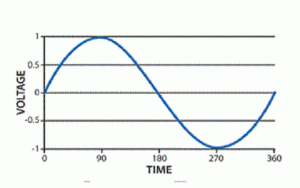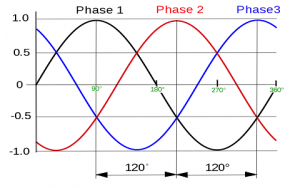The transmission of electrical energy which is received from power stations can be done through transmission lines. After that, it is supplied to substations through the main distribution. At last for domestic consumers, it is supplied through secondary distribution. The single-phase power is used in small premises as well as homes. But generally, 3-phase power is mostly used over 1-phase power because 3-phase machinery is more sufficient than a 1-phase. Let us discuss an overview of what is a phase, how many phases are practically used, what are the key differences between the 1 phase and 3 phase in this article.
What is a Phase?
- The distribution of electrical power I,e AC (alternating current) power supply vary with respect to the time period is expressed in terms of phase.
- Line ‘L’ is supposed to be known as one phase. Similarly, if we connect the supply between two lines I,e L-L then it is represented as two phases.
- If we connect supply between lines I,e L-L-L then it is known as three-phase supply. Depending upon the operation requirements suitable phase is selected and used.
Difference Between DC and AC
DC (Direct current)
- The power supply from a battery is represented as DC (direct current).
- The flow of current will be in one direction and does not alternate.
AC (Alternating current)
- The power supply from a phase is represented as AC (alternating current). In a phase, the current alternately varies between the zero and peak value in the form of a sinusoidal wave.
- The speed at which wave travels is known as frequency, which is expressed in ‘HZ’ and we normally use ‘50HZ’.
How Electricity is Generated, Transmitted and Distributed
- The electricity is produced far away from the power station. We produce and distribute AC (alternating current) because it is more adequate and convenient than DC (Direct Current).
- The produced voltage is expanded by a step-up transformer where it will be distributed to distant areas by transmission lines.
- The reason behind the step-up of voltage is we can reduce power losses in order to transfer to distant areas over transmission lines.
- At a substation, the voltage is reduced using a step-down transformer which is supplied to industries as primary distribution. Supply to the domestic users is termed as secondary distribution
What is Single-Phase?
- A 1 phase installation means the line is connected to one of the phases and as well as the neutral.
- The electricity flowing into your building is alternating current and it flows in and out continuously reversing its direction 50times a second.
- In power systems, 1-phase supply generally used for domestic appliances where the amount of load required is small. From the secondary distribution, we get one wire as phase and the other wire as neutral. One phase and neutral are used together to give a single-phase power supply.
- The 1-phase power supply uses AC power (alternating current) to be distributed to the domestic householders. In a 1 phase supply, the voltage varies sinusoidally with respect to the time period as shown in the figure.

Single Phase Waveform
- Since the voltage of a single-phase supply meets the maximum value of two times, the instantaneous power is not constant. For a single-phase system, 240V is supplied which sufficiently fulfills the needs of domestic users. A 1 phase system is not suitable for those motors whose ratings are high. The standard frequency of the 1 phase system is 50 Hz and varies from country to country.
Advantages of a Single-Phase System
- The 1-phase system can be applied to small loads.
- The design complexity of the 1- phase system is less.
- The operation cost is less.
Drawbacks of the Single-Phase System:
- The 1-phase cannot be applied for heavy loads.
- The 1-phase, when connected to an electric motor, is not able to develop a revolving magnetic field.
- 1-phase motors require some additional equipment to start.
Drawbacks of the single-phase system can be overcome in a three-phase supply system.
What is a Three-phase System?
- A 3-phase system is operated at 415v which is supplied to industries where heavy motors will be run. A 3-Phase waveform is shown in the figure.

- In a 3-phase system, the waves travel with a frequency and current waves vary alternately in between zero and peak values. The individual phases are separated from each other by an angle of 120 degrees.
Advantages of Three-Phase
- A 3-phase system is more economical than a 1 phase as it requires less conducting material than a 1 phase.
- High industrial loads can be operated by a 3-phase system.
- Highly reliable.
- It requires less maintenance.
Difference Between Single and Three Phase Power?
- The key difference between 1 phase and 3 phase is their supply of voltage. 1 phase supplies a voltage of 240V whereas 3 phase supplies 415V.
- 1 phase supply is used by domestic householders. 3 phase supply is used by industrial consumers.
Advantages of Three-Phase over Single-Phase
- The output of the 3-phase system is more compared to a 1-phase.
- The size of the machine is less.
- About 45% of output produced will be higher than that of a 1-phase.
- The 3-phase windings are capable of producing a rotating magnetic field. The 3-phase machines are self-starting whereas 1-phase motors require an external starting device.
- In a transmission system, it is possible to transmit more power by three-phase than a 1-phase without losses compared to a 1-phase system.
- The H.P (horsepower) and KVA rating of 3-phase is far higher than that of a 1-phase.
- The power factor of the 3-phase system is better than that of a 1-phase system.
- Power delivered by a 1-phase system fluctuates as it reaches zero three times each cycle. In the 3-phase system, the power delivered also fluctuates. But never reaches zero which produces superior operating characteristics than a 1 phase system.
- If the same amount of power is to be supplied, a 3-phase system requires less area of cross-section compared to the 1-phase system.
Know more about Alternating Current and Voltage MCQs.
Thus, this article gives an overview of the distribution of electrical power with respect to the time period. We have also discussed what is 1-Phase and 3-Phase and discussed the difference between them. Apart from this, we also studied the advantages and drawbacks of both Phases. Here is a question for you, Write a comparison chart between 1-phase and 3-phase?

